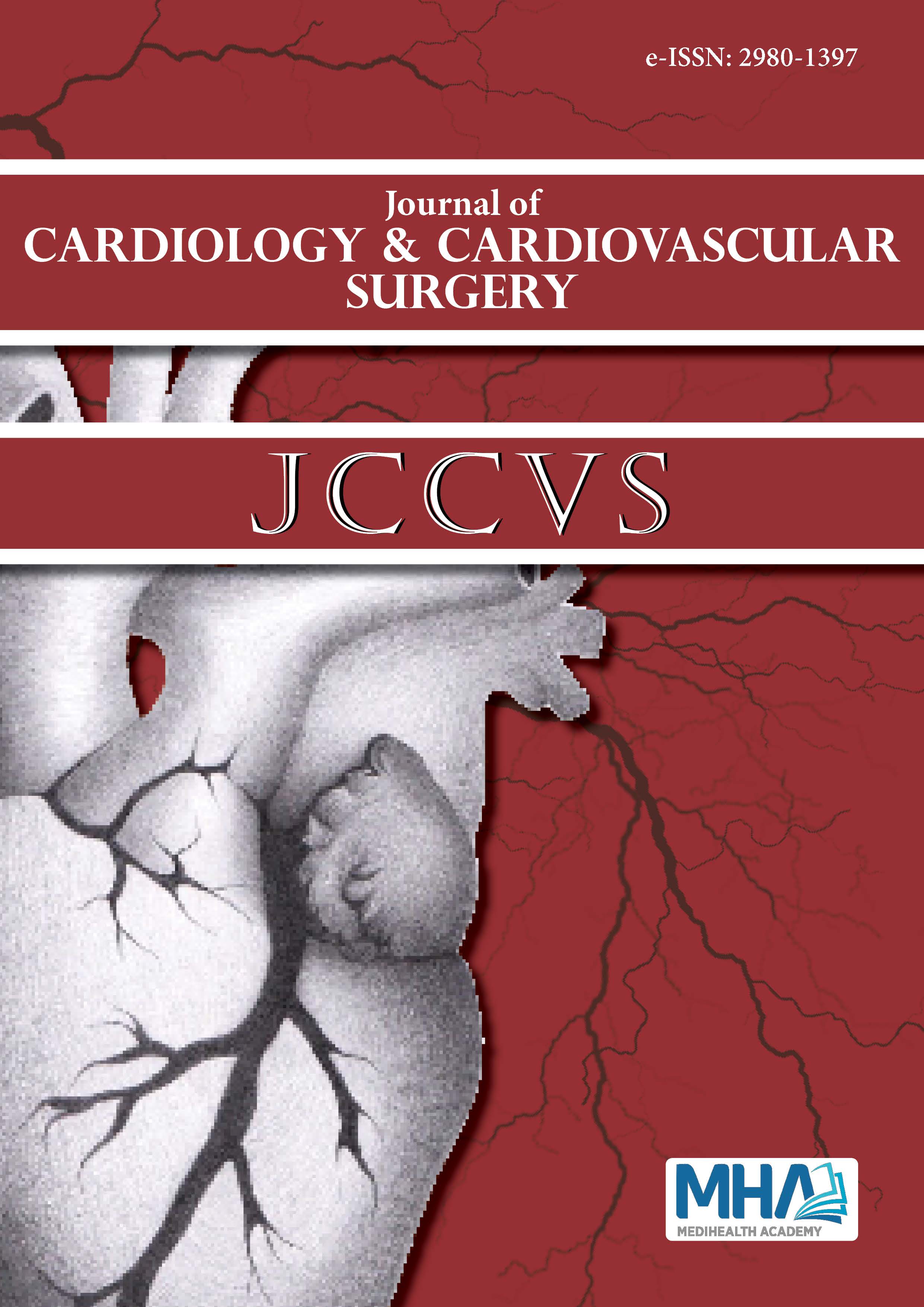1. Shi S, Qin M, Shen B, et al. Association of cardiac injury with mortalityin hospitalized patients with COVID-19 in Wuhan, China. JAMACardiol. 2020;5(7):802-810. doi: 10.1001/jamacardio.2020.0950
2. Guo T, Fan Y, Chen M, et al. Cardiovascular implications of fataloutcomes of patients with coronavirus disease 2019 (COVID-19). JAMACardiol. 2020;5(7):811-818. doi: 10.1001/jamacardio.2020.1017
3. Inciardi RM, Lupi L, Zaccone G, et al. Cardiac involvement in apatient with coronavirus disease 2019 (COVID-19). JAMA Cardiol.2020;5(7):819-824. doi: 10.1001/jamacardio.2020.1096
4. Chen L, Li X, Chen M, Feng Y, Xiong C. The ACE2 expression inhuman heart indicates new potential mechanism of heart injury amongpatients infected with SARS-CoV-2. Cardiovasc Res. 2020;116(6):1097-1100. doi: 10.1093/cvr/cvaa078
5. Varga Z, Flammer AJ, Steiger P, et al. Endothelial cell infection andendotheliitis in COVID-19. Lancet. 2020;395(10234):1417-1418. doi:10.1016/S0140-6736(20)30937-5
6. Zheng YY, Ma YT, Zhang JY, Xie X. COVID-19 and the cardiovascularsystem. Nat Rev Cardiol. 2020;17(5):259-260. doi: 10.1038/s41569-020-0360-5
7. Friedrich MG, Sechtem U, Schulz-Menger J, et al. InternationalConsensus Group on Cardiovascular Magnetic Resonance inMyocarditis. Cardiovascular magnetic resonance in myocarditis: AJACC White Paper. J Am Coll Cardiol. 2009;53(17):1475-1487. doi:10.1016/j.jacc.2009.02.007
8. Ferreira VM, Schulz-Menger J, Holmvang G, et al. Cardiovascularmagnetic resonance in nonischemic myocardial inflammation: expertrecommendations. J Am Coll Cardiol. 2018;72(24):3158-3176. doi:10.1016/j.jacc.2018.09.072
9. Kammerlander AA, Marzluf BA, Zotter-Tufaro C, et al. T1Mapping by CMR imaging: from histological validation to clinicalimplication. JACC Cardiovasc Imaging. 2016;9(1):14-23. doi: 10.1016/j.jcmg.2015.11.002
10. Huang L, Zhao P, Tang D, et al. Cardiac involvement in patientsrecovered from COVID-2019 identified using magnetic resonanceimaging. JACC Cardiovasc Imaging. 2020;13(11):2330-2339. doi:10.1016/j.jcmg.2020.05.004
11. Puntmann VO, Carerj ML, Wieters I, et al. Outcomes of cardiovascularmagnetic resonance imaging in patients recently recovered fromcoronavirus disease 2019 (COVID-19). JAMA Cardiol. 2020;5(11):1265-1273. doi: 10.1001/jamacardio.2020.3557
12. Paternoster G, Bertini P, Innelli P, et al. Right ventricular dysfunctionin patients with COVID-19: a systematic review and meta-analysis.J Cardiothorac Vasc Anesth. 2021;35(11):3319-3324. doi: 10.1053/j.jvca.2021.04.008
13. Lazzeri C, Bonizzoli M, Batacchi S, Peris A. Echocardiographicassessment of the right ventricle in COVID -related acute respiratorysyndrome. Intern Emerg Med. 2021;16(1):1-5. doi:10.1007/s11739-020-02494-x
14. Ekizler FA, Cay S, Tak BT, et al. Usefulness of the whole blood viscosityto predict stent thrombosis in ST-elevation myocardial infarction.Biomark Med. 2019;13(15):1307-1320. doi: 10.2217/bmm-2019-0246
15. Yildirim A, Kucukosmanoglu M, Koyunsever NY, Cekici Y, BelibagliMC, Kilic S. Relationship between blood viscosity and no-reflowphenomenon in ST-segment elevation myocardial infarction performedin primary percutaneous coronary interventions. Biomark Med.2021;15(9):659-667. doi: 10.2217/bmm-2020-0772
16. Çınar T, Şaylık F, Akbulut T, et al. The association between whole bloodviscosity and high thrombus burden in patients with non-ST elevationmyocardial infarction. Kardiol Pol. 2022;80(4):429-435. doi: 10.33963/KP.a2022.0043
17. Tekin Tak B, Ekizler FA, Cay S, et al. Relationship between apical thrombusformation and blood viscosity in acute anterior myocardial infarctionpatients. Biomark Med. 2020;14(3):201-210. doi: 10.2217/bmm-2019-0483
18. Aksu E. Is it possible to estimate the mortality risk in acute pulmonaryembolism by means of novel predictors? A retrospective study. Turkish JVasc Surg. 2021;30(1):27-34. doi: 10.9739/tjvs.2021.836
19. Antonova N, Velcheva I. Hemorheological disturbances andcharacteristic parameters in patients with cerebrovascular disease. ClinHemorheol Microcirc. 1999;21(3-4):405-408.
20. Mitchell C, Rahko PS, Blauwet LA, et al. Guidelines for performing acomprehensive transthoracic echocardiographic examination in adults:recommendations from the American Society of Echocardiography. JAm Soc Echocardiogr. 2019;32(1):1-64. doi: 10.1016/j.echo.2018.06.004
21. Chang WT, Toh HS, Liao CT, Yu WL. Cardiac involvement ofCOVID-19: a comprehensive review. Am J Med Sci. 2021;361(1):14-22.doi:10.1016/j.amjms.2020.10.002
22. Ceyhun G, Birdal O. Relationship between whole blood viscosity andlesion severity in coronary artery disease. Int J Angiol. 2021;30(2):117-121. doi:10.1055/s-0040-1720968
23. Lowe GD, Drummond MM, Lorimer AR, et al. Relation betweenextent of coronary artery disease and blood viscosity. Br Med J.1980;280(6215):673-674. doi: 10.1136/bmj.280.6215.673
24. Cekirdekci EI, Bugan B. Whole blood viscosity in microvascular anginaand coronary artery disease: significance and utility. Rev Port Cardiol(English Edition). 2020;39(1):17-23. doi: 10.1016/j.repc.2019.04.008
25. Hudak ML, Koehler RC, Rosenberg AA, Traystman RJ, Jones JrMD. Effect of hematocrit on cerebral blood flow. Am J Physiol.1986;251(1):H63-H70. doi: 10.1152/ajpheart.1986.251.1.H63
26. Uzunget SB, Sahin KE. Another possible determinant for ischemicstroke with nonvalvular atrial fibrillation other than conventionaloral anticoagulant treatment: the relationship between whole bloodviscosity and stroke?. J Stroke Cerebrovasc Dis. 2022;31(9):106687. doi:10.1016/j.jstrokecerebrovasdis.2022.106687
27. Li H, Zhu H, Yang Z, Tang D, Huang L, Xia L. Tissue characterization bymapping and strain cardiac MRI to evaluate myocardial inflammationin fulminant myocarditis. J Magn Reson Imaging. 2020;52(3):930-938.doi:10.1002/jmri.27094
28. Dolan RS, Rahsepar AA, Blaisdell J, et al. Multiparametric cardiacmagnetic resonance imaging can detect acute cardiac allograft rejectionafter heart transplantation. JACC Cardiovasc Imaging. 2019;12(8 Pt 2):1632-1641. doi: 10.1016/j.jcmg.2019.01.026
29. Hinojar R, Varma N, Child N, et al. T1 mapping in discrimination ofhypertrophic phenotypes: hypertensive heart disease and hypertrophiccardiomyopathy: findings from the international T1 multicentercardiovascular magnetic resonance study. Circ Cardiovasc Imaging.2015;8(12):e003285. doi: 10.1161/CIRCIMAGING.115.003285
30. Park JF, Banerjee S, Umar S. In the eye of the storm: the rightventricle in COVID-19. Pulm Circ. 2020;10(3):2045894020936660.doi:10.1177/2045894020936660
31. Grasselli G, Tonetti T, Protti A, et al. Pathophysiology of COVID-19-associated acute respiratory distress syndrome: a multicentreprospective observational study. Lancet Respir Med. 2020;8(12):1201-1208. doi: 10.1016/S2213-2600(20)30370-2
32. Bleakley C, Singh S, Garfield B, et al. Right ventricular dysfunctionin critically ill COVID-19 ARDS. Int J Cardiol. 2021;327:251-258. doi:10.1016/j.ijcard.2020.11.043

